Latest News Release
Movement Application form to print off and fax to AgriQuality New Zealand (Bee Response Head Quarters) is located here.
23 July 2001
LATEST VARROA TRACKING MAPS
Below are two latest maps showing recent spread of the varroa mite.
Please click on them for an enlarged view.
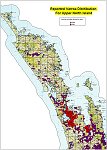 Upper North Island |
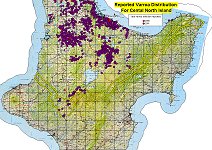 Central North Island |
23 July 2001
Meeting to Review Options re Movement Controls surrounding Current Boundary Line in Central North Island
To download the above minutes Click Here (pdf file 164kb)
6 July 2001
Compensation issues resulting from the Varroa delimiting survey
The Executive is aware that there are many compensation claims that members feel are not progressing towards any sort of conclusion.
In order to establish whether there is any action the Association can take on behalf of members to expedite their claims we need to ascertain what is holding things up and whether there is any commonality across the various claims.
If you feel this is you, or know of someone who feels they are in this situation, please send a brief written summary of your issues (no more than one page) to Head Office by 30 July 2001:
Compensation Issues
National Beekeepers' Association
P O Box 715
Wellington.
Many thanks
Tim Leslie
Executive Secretary
20 June 2001
LATEST VARROA TRACKING MAPS
Below are two latest maps showing recent spread of the varroa mite.
Please click on them for an enlarged view.
 Upper North Island |
 Central North Island |
22 May 2001
RISK ASSESSMENT OF VARROA INTRODUCTION INTO THE SOUTH ISLAND OF NEW ZEALAND
To download the above report Click Here (doc file)
A Review of Treatment Options
For Control of Varroa Mite in New Zealand
To download the above report Click Here (pdf file 529kb)
7 May 2001
LATEST VARROA TRACKING MAPS
Below are two latest maps showing recent spread of the varroa mite.
Please click on them for an enlarged view.
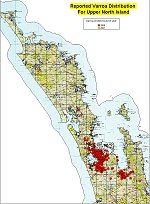 Upper North Island |
 Central North Island |
7 May 2001
VARROA IN NEW ZEALAND: ECONOMIC IMPACT ASSESSMENT
This paper presents an assessment of the economic impacts of varroa on New Zealand agriculture. These impacts include both direct effects on the beekeeping sector and increased costs of production and production losses to industries in the horticultural, pastoral and arable sectors that depend on honey bees for pollination. Given uncertainty as to how adverse the impacts of varroa might be and how rapidly these impacts might spread throughout New Zealand, a range of scenarios are modelled. This economic impact assessment suggests that, under beekeeper management only, varroa is likely to cost New Zealand agriculture at best around $400 million and at worst around $900 million, in present value terms, over the next 35 years.
The above report is on this page.
 1 May 2001
1 May 2001
Melittiphis and Varroa Comparison
Varroa can be mistaken for the melittiphis mite, although melittiphis is smaller and different in shape.
Melittiphis is about 1/4 the size of varroa, and is different in shape. It does, however, tend to be quite similar in colour to varroa.
Picture shows a comparison between varroa (top) and melittiphis (bottom)
16 March 2001
LATEST VARROA TRACKING MAPS
Below are two maps showing recent spread of the varroa mite.
Please click on them for an enlarged view.
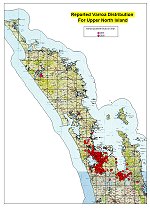 Northland |
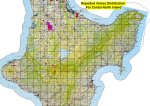 Central North Island |
23 November 2000
TWO YEAR INTERIM MANAGEMENT PROGRAMME FOR VARROA BEE MITE
Office of the Minister of Agriculture
The above report is on this page.
25 October 2000
Varroa destructor Management Programme: Guide to completing a claim for compensation under section 162A of the Biosecurity Act 1993
Plus Varroa Compensation Claim Form 5 (Available for download here)
The above report is on this page.
11th October 2000
MEDIA RELEASE
BEEKEEPERS' WANTED LARGER PREVENTIVE PROGRAM
The National Beekeepers' Association has backed the Government's approval of limited prophylactic, or preventative, chemical treatment of beehives.
"The National Beekeepers' Association welcomes the Government's recognition of the urgency of the varroa treatment situation as hive movements associated with horticultural pollination becomes imminent," said spokesman Lin McKenzie.
Hives that qualify under the Cabinets decision are eligible for free treatment.
"The targeted prophylactic treatment approved earlier this week by Cabinet will go a good way to mitigating the danger of varroa spread during the moving of pollination hives, and this is acknowledged as being a positive move by the NBA."
Under the present regime, only hives known to be infected, or have a high probability of being infected, and all hives being moved onto pollination sites with known varroa infestations, or where there is a high risk of varroa spread, are currently eligible.
"The NBA accepts the Governments decision, however we believe the risks could be further reduced by broadening the scope of targeting to include all pollination hives where they are in the same area as hives identified as coming from high risk areas, although technical advice warns of potential for chemical resistance if prophylactic treatment is used medium to long term."
4th October 2000
MOVEMENT PERMITTING CONDITIONS
Read the above report on this page.
4th October 2000
Notes from the Phase II Varroa Management Meeting 20.09.00
Read the above report on this page.
15 August 2000
13 Regional Meetings to Discuss Varroa Management Plan
including the REGIONAL MEETING TIMETABLE on this page.
13 July 2000
MAF to begin treatment of infected hives
Plus a question and answer sheet for further
information.
Read the above report on this page.
12 July 2000
 GOVERNMENT BACKS VARROA
MANAGEMENT PLAN
GOVERNMENT BACKS VARROA
MANAGEMENT PLAN
The Government has ruled out attempting to eradicate the Varroa bee mite and has opted for a Government-assisted management programme the Minister of Agriculture Jim Sutton and the Minister for Biosecurity, Marian Hobbs, announced today.
"We considered carefully the views of the beekeeping and other primary sector industries and also of the independent technical group," the Ministers said. "In the end we accepted that the chances of successfully eradicating the Varroa mite were minimal. A failed eradication attempt would weaken beekeeping and pollination-dependent industries and jeopardise long-term management.
"Therefore Cabinet has agreed in principle to work with the industry in a three-stage management plan. We are committed to achieving containment and minimising the impact of the mite.
The Ministry of Agriculture and Foresty has been directed to work with industry to finalise an operational plan and to report back to the Government by mid-September. The Ministry of Social Policy and MAF will also, in consultation with the beekeeping industry, review the need for rural sector income support measures.
The Ministers said the Cabinet had rejected with the greatest reluctance the option of attempting the total eradication of the bee mite.
"At an estimated cost of $55 million, money was not a factor but all our advice considered the chances of success were low. Eradication would require the depopulation of all managed and feral bees over at least 5000 square kilometres including rugged terrain from the central North Island to Hokianga. Our advice is that there will be further sites of infestation not yet detected
"Long-term management uses chemicals to kill varroa mites in managed hives while leaving the bees in those hives healthy.
The Government has approved initial expenditure of almost $1.3 million for the management plan which has three stages:
- Immediate control (over the next 10 weeks). Beekeepers
from all infested apiaries and apiaries within a five
kilometre radius of an infested apiary, will be
offered free treatment of hives with a registered
chemical.
- Interim control, (a two-year Government supported management programme which is likely to include financial assistance and support). The aim is to keep the South Island free of varroa for as long as possible and to reduce the effects of the mite in the North Island. A draft operational plan is with the industry for comment.
- Long term control, beyond two years. An agreed long-term management plan under the Biosecurity Act. Infestations are prevalent and heavy around Auckland, Pukekohe and Hauraki Plains as a result of natural spread. Beekeeping activity has spread varroa to several outlying sites including Helensville, Te Puke and Hokianga and to single sites at Te Awamutu, Otorohanga and National Park. Feral bees are also known to be infected.
- Interim control, (a two-year Government supported management programme which is likely to include financial assistance and support). The aim is to keep the South Island free of varroa for as long as possible and to reduce the effects of the mite in the North Island. A draft operational plan is with the industry for comment.
A total of 3022 apiaries containing 58,163 hives were
inspected. The survey detected 248 infected apiaries,
containing 4060 hives, owned by 132 beekeepers.
26 June 2000
THE OPERATIONAL PLAN FOR ERADICATION OF VARROA
Read the above report on this page.
24 June 2000
MINUTES OF AN EXTRAORDINARY MEETING OF THE NATIONAL BEEKEEPERS ASSOCIATION, AUCKLAND BRANCH
Read the above report on this page.
16 June 2000
OPERATIONAL PLAN CONTROL OF VARROA
Read the above report on this page.
REMITS FOR CONSIDERATION BY THE NATIONAL BEEKEEPERS' ASSOCIATION CONFERENCE OF BRANCH DELEGATES GISBORNE, 19 AND 20 JULY 2000
Read the above report on this page.
| Date: | 9 June 2000 |
| To: | The Honorable Mr Jim Sutton |
| Minister of Agriculture | |
| Fax No: | 04 4958447 |
| Re: | VARROA |
Dear Mr Sutton,
Further to my submissions to you 7 June 2000, (copy enclosed) and the very good Assignment programme last night, I would like to make further urgent submissions supporting the eradication of Varroa. Please, I again request an urgent appointment to discuss these submissions.
- I believe we must attempt to eradicate Varroa mite with great vigour during the next 12 months. Then in 12 months time, reassess the situation and make a decision at that time as to whether an eradication programme should be continued, or that we should switch over to the control of the spread of Varroa mites.
- If it is decided at that time that eradication is not possible, the eradication programme will greatly enhance the control programme.
- What I am suggesting is that it is absolutely essential that we go down the eradication track first, even if the chance of eradication is not as high as you would like to see it. The decision on whether to eradicate, I am sure, will be determined by what chance of successful eradication is acceptable. I believe that this chance of successful eradication can be a lot lower and yet be acceptable to everybody, because if it is not successful, it would still be the ideal lead-in to control.
The fundamental points to increase the chances of eradication are:-
- Eradication should start immediately as set out in the enclosed document, but including Auckland (changed from submission to you as delays will mean most of the beehives in this area will die or be in too poor a condition to be used for pollination).
- I am recommending that the farmed hives and feral colonies in the Te Puke area should be eradicated before pollination and that if eradication is successful and not many mites are found in ferals and Apistan strips are placed in hives during pollination, these hives on removal from orchards should not be depopulated. If depopulation of ferals has not been successful and a high % of Varroa is found in ferals, then the hives shifted into orchards may also have to be depopulated in the Te Puke area, after pollination.
- No hive movements or bee movements allowed in the Infected and Buffer zones and possibly even the Surveillance zone for the following seven months, from 1 January to 1 August 2001. This will greatly improve the chance of eradicating Varroa mite.
(see enclosed) - I now believe that beehives and feral colonies in the Auckland Infected zone should be immediately depopulated. The hives which have to be placed into pollination should then be depopulated, the depopulation should then carry on with ferals until 1 August 2001, at which point a decision should be made.
- I do not believe any hives or bees should be allowed to be shifted from the Buffer zone to the Surveillance zone. The line between these two zones is likely to be critical in eradication or control.
- Further issues which give further support to the above eradication recommendations. Clover Weevil I believe, will affect the costs that the Varroa mite will have on pastoral farming and this may not be fully taken into account and understood by those people presently doing the costings. What I am saying is that where you have clover weevil in the pasture it is more important than ever to have good pollination of the remaining flowers, by bees.
- It is very difficult to be sure how far and fast Varroa is going to spread in New Zealand, particularly when you take into account the biodiversity of bees in New Zealand which has had no legal introduction of live bees for over 50 years.
- I believe there has not been enough consideration given to the effect to New Zealand's economy, if we have an additional incursion of our border and another exotic bee disease arrives in New Zealand and we have not eradicated Varroa. It will be absolutely devastating.
- Compensation must be adequate to beekeepers. I believe $125 per hive with a $25 cleaning and storage cost should meet this requirement.
- This eradication programme will maximise the chance that the essential requirement of kiwifruit growers and other orchardists receiving hives for pollination is, met.
- The cost of this programme will be less than what is envisaged in the Operational Plan Eradication of Varroa 25 May 2000, while having a far greater chance of eradicating Varroa because of the total ban of bee and hive movement for seven months in the Infected and Buffer zones.
Regards,
Russell Berry
7 June 2000
OPERATIONAL PLAN ERADICATION OF VARROA
Read the above report on this page.
6 June 2000
Information for discussion by the New Zealand Beekeeping Industry, SOE's, Government departments and Parliamentarians.
WHY DO WE HAVE VARROA SO WIDESPREAD IN NEW ZEALAND BEFORE DETECTION?
CAN WE ERADICATE VARROA?
HOW DO WE ERADICATE VARROA?
Read the above report by Russell Berry on this page.
For Varroa News Dated 14 May to 2 June click here
For Varroa News Dated 24 April to 12 May click here
For Varroa News Dated 12 April to 20 April click here
© 2000 All information within this website is copyright of the National Beekeepers Assn